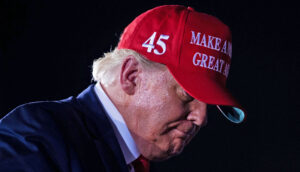It is now clear that the Russian invasion of Ukraine marked the end of one era in world politics and the beginning of a new one. As with the fall of the Berlin Wall in 1989, the collapse of détente following the Soviet invasion of Afghanistan in 1979, and the Korean War in 1950, it is too early to predict the outcome of what can only be called Cold War II. One consequence, however, is already clear: the acceleration of the domination of Europe by the United States.
Since the Fifties, there has been support for European strategic autonomy among both Euro-Gaullists seeking to minimise US influence on European defence and Americans who hope to shift the burden of protecting Europe to Europeans themselves. Yet in nearly seven decades, no credible European alternative to Nato has ever been constructed.
After this week’s Nato summit, one can only conclude that the dream of European military independence must once again be deferred, this time for a decade or a generation or even longer. The reaction to Putin’s invasion showed that only the US has the unity and the military infrastructure to coordinate multinational military efforts in or near Europe. The conflict has underlined the dependence of America’s European allies on the US military even more dramatically than the Balkan Wars and the Libyan adventure.
The expansion of Nato to include Finland and Sweden, and almost certainly Ukraine in the relatively near future, will only further strengthen the influence of the US in the transatlantic alliance. As a rule, the closer a Nato country is to Russia, the more favourable it tends to be towards the US. Donald Rumsfeld acknowledged this after the invasion of Iraq, scorning the sceptics in “old Europe” (France and Germany) while praising the “new Europe” formed by countries freed from the Soviet bloc. Today, Poland has embraced its role on the front lines of Cold War II, committing itself to spending at least 3% of its GDP on defence. Such hawkishness strengthens the US while weakening France and Germany, which were more likely to favour good relations with Russia.
In a prolonged cold war, then, we shouldn’t be surprised if the European Union plays an increasingly subordinate role to Nato. After all, with the accession of Ukraine to the EU, which seems likely to follow or accompany Ukraine’s eventual admission to Nato, the EU will have 28 members — fewer than the 32 members of Nato, following the accession of Finland and Sweden, or 33, if Ukraine joins. In other words, more European countries will be members of Nato, whose hegemonic power is the United States, than of the EU, dominated by the partnership of Germany and France.
The post-Ukraine geopolitical landscape will therefore represent the end, at least for now, of the Gaullist dream of a European superpower led by France. It will also represent the end of Germany’s attempt to have the best of all worlds as America’s defence protectorate, Russia’s energy customer and a major Chinese trading partner. Europeans may prefer to call decoupling from the Chinese economy “de-risking”, but, whatever the term may be, the phenomenon is likely to accelerate at the insistence of the Washington’s policymakers of both parties, for whom Cold War II is a single global conflict against a de facto Sino-Russian bloc.
This is not to say that individual European countries, or perhaps the EU as a whole, will be as strict towards trade and technology transfers as their American strategic partner. But while they may prefer to avoid the choice, when pressed, most European countries can be counted on to side with the US, the devil they know, rather than the secretive, authoritarian Chinese communist regime.
In previous generations, proposals such as the ill-fated Transatlantic Trade and Investment Partnership, a Nato for trade, have foundered on the opposition of businesses and citizens in European countries. To this day, many in Britain fear that transatlantic rule-making might lead to the privatisation and destruction of the cherished National Health Service, while European farmers have reservations about competition with US agribusiness.
But America is far from the only, let alone most significant, commercial threat to Europe. According to the German insurer Allianz, the European car industry now faces a critical challenge from Chinese automobile imports. And in time, China’s state-sponsored passenger jet manufacturing industry may cut into the global duopoly that the EU’s Airbus and America’s Boeing have enjoyed for generations. Threatened by government-backed Chinese mercantilism in one global market after another, European industries could soon reconsider their scepticism about a transatlantic trade bloc.
Elsewhere, demographic trends will further accelerate the shift in economic and military power from Europe to the US. In 1960, America’s population was roughly 180 million, compared to 406.8 million in what became the EU — around 44% of the EU total. Today, largely as a result of recent immigration-driven population growth, the US has a population of 334 million — roughly 75% of the EU population in 2022 of 447 million people. Assuming a continuation of net annual migration of 1 million individuals a year to the US, by 2060 its population could be 405 million— 80% of the projected 517 million Europeans.
Any such projections must of course be taken with treated with scepticism, given uncertainties about fertility rates and national immigration policies. Yet in light of the support for mass immigration by the bipartisan US elite, regardless of popular sentiment, a growing American share of the transatlantic population certainly seems likely. And even demographic near-parity between the US and EU understates the American economic advantage over Europe. American global corporations tend to out-compete European firms because they benefit from having a single huge domestic market that allows them to reap increasing returns. While a colossal home market similarly benefits Chinese firms, European integration has not yet been able to provide an equivalent single market and probably never will.
Unlike military potential and commercial weight, culture remains intangible. But America’s influence in the realm of mass entertainment, the arts and ideas within the West seems to be growing as well. From the 19th century until after the Second World War, the transatlantic balance of trade in ideas favoured Western Europe. American artists and connoisseurs made pilgrimages to Paris, the global capital of the art world, to discover the new trends in painting and sculpture and architecture. In living memory in the Sixties and Seventies, American film students analysed the work of French and Italian directors, while educated Americans had to have at least a bluffer’s guide’s worth of knowledge about contemporary German, French and British philosophy. In American universities, reverent students listened to accented “Herr Professors” — émigré intellectuals who had fled from National Socialism or Soviet communism. And as recently as the Nineties, there were lively transatlantic debates on the relative merits of Anglo-American liberal capitalism, German social-market capitalism and Nordic social democracy.
Yet in the last half century, the flow of both pop and highbrow culture across the Atlantic has reversed and now runs West to East. The last major European intellectual movement to influence American academic life was French post-structuralism, a phenomenon of the Sixties and Seventies which American professors discovered belatedly and largely in translation in the succeeding decades. Asked to name an influential contemporary German philosopher, most American intellectuals would be at a loss to name any other than Jurgen Habermas, who is 94.
Meanwhile, the most toxic aspects of America’s progressive intellectual culture, incubated on American university campuses, have spread like a contagion across Britain and Western Europe. American multiculturalism became “Multikulti” in Merkel’s Germany. Thanks to transgender ideology imported from the US, British police now identify male transgender sex offenders as “she” and the Anglican church is debating the pronouns of the Almighty. Perhaps most absurd of all, from an American perspective, were the Black Lives Matter protests that took place across Europe, complete with iconic images of George Floyd. That was the high watermark of contemporary American cultural hegemony over Europe — at least to date.
Turnabout is fair play, perhaps. For most of American history, the US was a cultural colony of Britain and Europe. The cutting-edge innovations in American art, literature and thought tended to be the fashions of Western Europe a generation or two before. Now, however, American artists, writers and thinkers can visit Europe and encounter people who treat yesterday’s American cultural and academic fads as fresh and exciting. To add insult to injury, American English is the lingua franca of Europe. Do Europeans outside of those countries still study the languages of Germany and France?
In 2008, Edouard Balladur, a former prime minister of France, published For a Union of the West: Between Europe and the United States, in which he called for Europe and the US to join forces in response to rising competition from China and the rest of the non-Western world. Here, he identified a genuine challenge and then, in French fashion, proposed to create a complex and bureaucratic transatlantic union.
Yet if deeper transatlantic integration does emerge, it will not be the result of formal institutions and procedures. It will result from deepening American hegemony over Europe, building on existing trends and accelerated by the dynamics of Cold War II in the aftermath of the war in Ukraine. Having achieved its goals at the Nato summit in Vilnius, America can be expected to promote ever closer military and commercial alignment with Europe — in the service of Washington’s China-centered strategy.
Disclaimer
Some of the posts we share are controversial and we do not necessarily agree with them in the whole extend. Sometimes we agree with the content or part of it but we do not agree with the narration or language. Nevertheless we find them somehow interesting, valuable and/or informative or we share them, because we strongly believe in freedom of speech, free press and journalism. We strongly encourage you to have a critical approach to all the content, do your own research and analysis to build your own opinion.
We would be glad to have your feedback.
Source: UnHerd Read the original article here: https://unherd.com/



